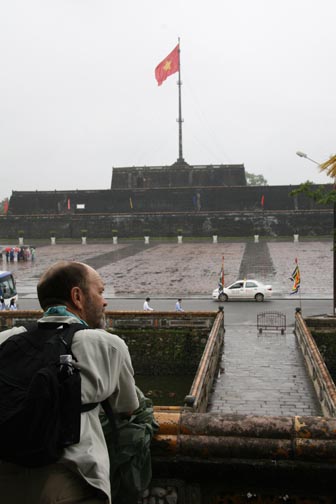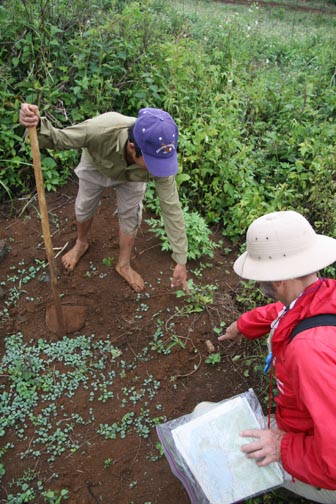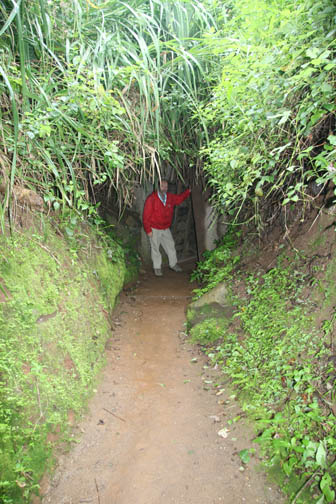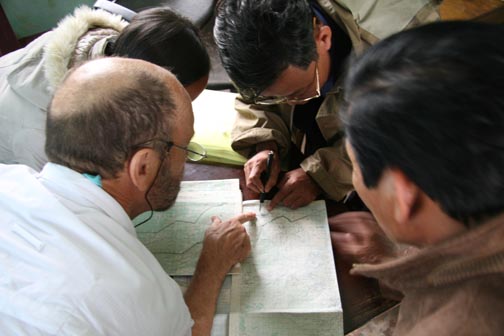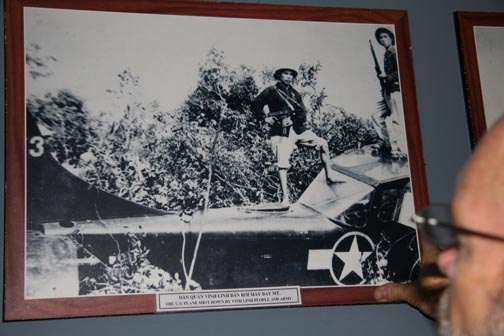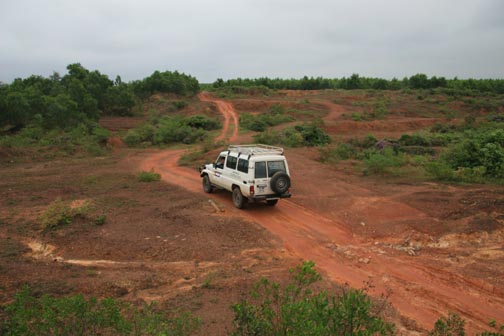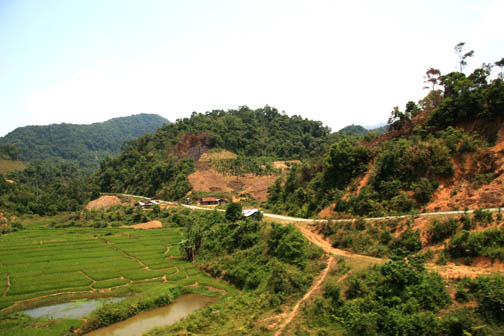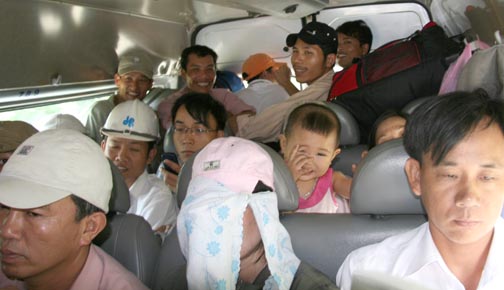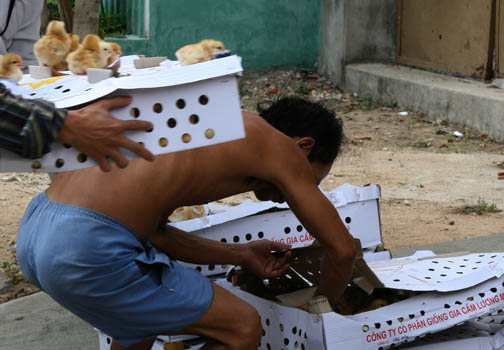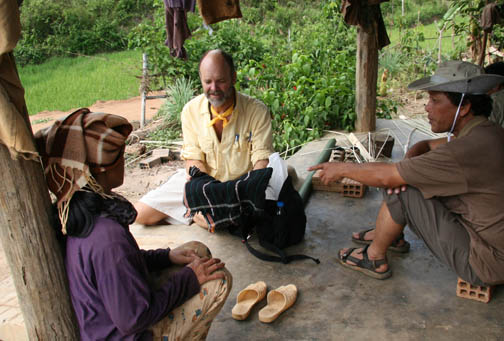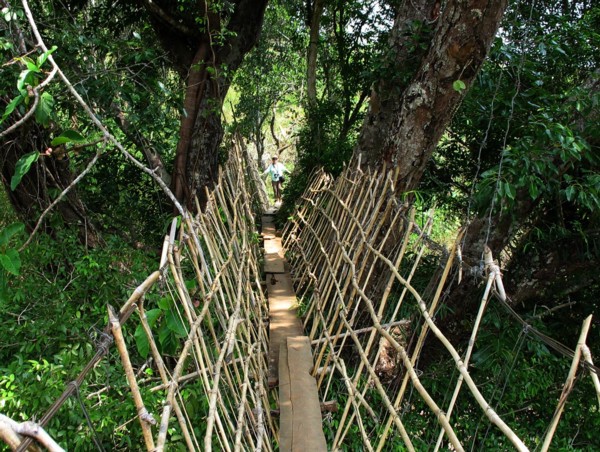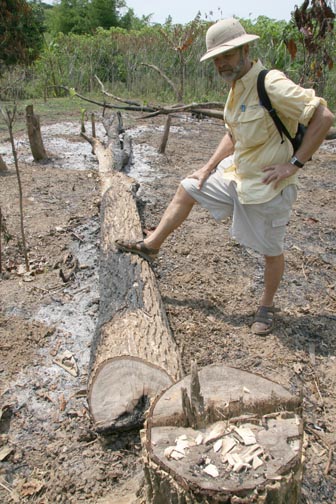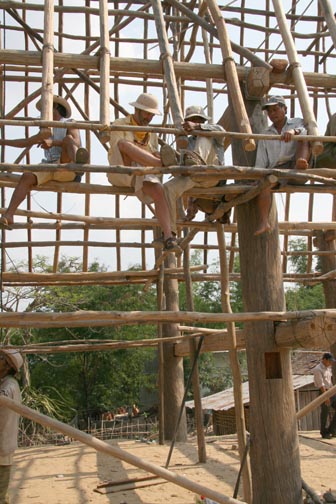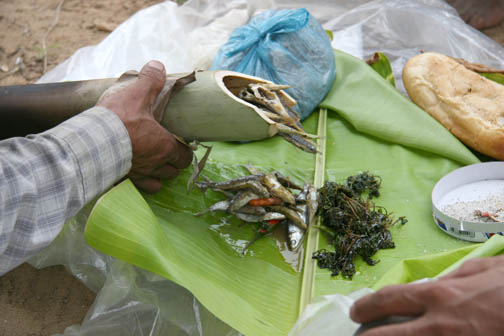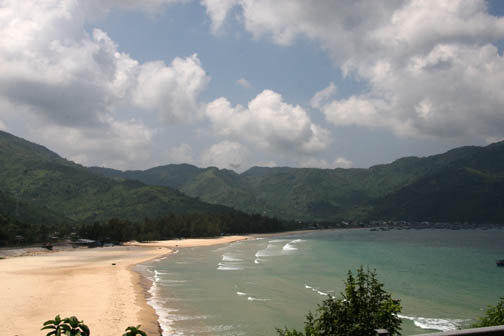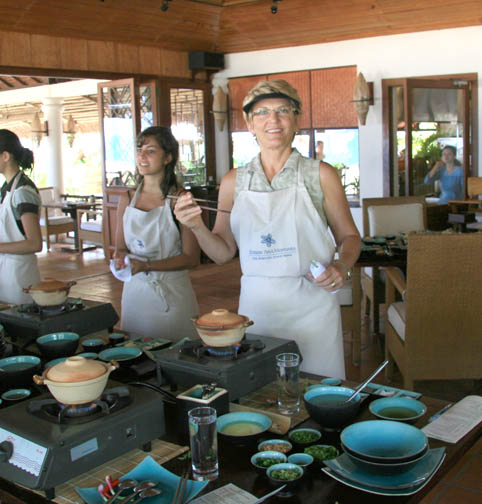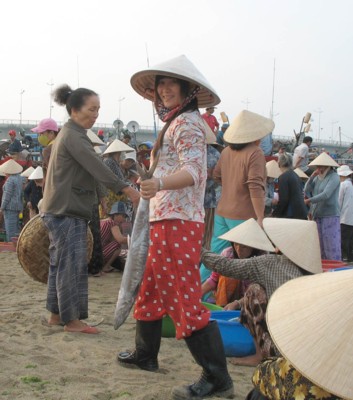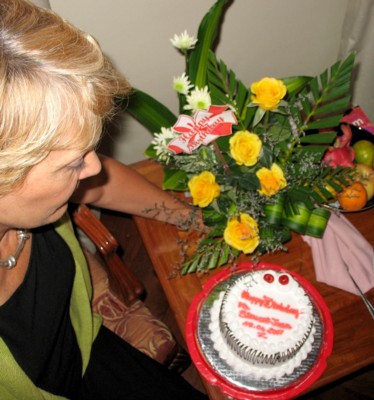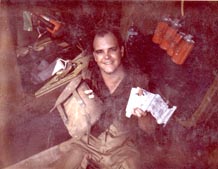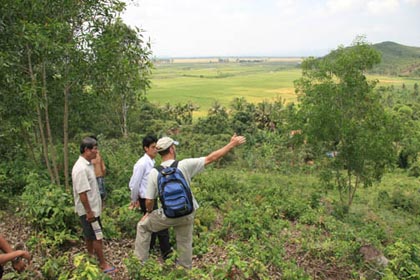220th Reconnaissance Airplane Company
Second Quarterly 2007 CATCOM E-Newsletter
updated May 4, 2007 (morning)
Jerry DeGrezio's son, Micah, in Afghanistan
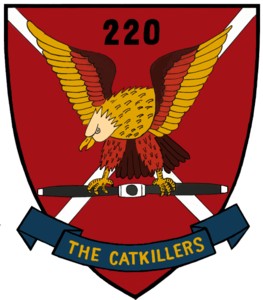
"Catkillers"
and Family,
and all Friends
and Brothers in Arms,
in memory of those who have served
NOTE FROM JOHN HILLMAN:
As you might know, John Hillman has experienced a relapse and is again under his doctor's care. He sent this note yesterday, and when you are in prayer please include our well-loved brother, John (and his ex-wife Riga), in your petitions and prayers. May God bless and keep you, John and Riga:
Don:
Thanks so much for the offer of help, I appreciate any help I can get from the MAN upstairs. I don't mind if you mention it in the newsletter. This development was not unexpected, it's the nature of this type of Cancer. I was told long ago this would occur, the doctors were right apparently. I simply view this just like a chip light in the tri-boarders area........acknowledge the problem, formulate a plan of action, implement it, and if the plan was good, the results should be the same. We have no control over the hands we are dealt, all we can do is play them to the best of our ability. Being a " glass is half full person, " I believe this is but a little bump in the road which I will overcome.
Don, thanks very much for your thoughts. I hope this note finds you in good spirits and good heath. You and all my other brothers are in my thoughts often.
John
DISPATCHES FROM VIETNAM, FROM ROD STEWART:
Dispatch #3 from the Mekong [For other dispatches, see the First Quarterly 2007 newsletter]:
Like slavery and other such human vices, colonialism is now considered bad. It had its period of respectability that has come and gone. But if we can admire the antebellum mansions that American slavery made possible & then it is OK for me to lust after the old river steamboats that once carried the colonial masters up the great rivers of the world. Mark Twain glorified life on the Mississippi; Kipling told the British Empire of the "great gray greasy Limpopo�; and Indochina served up even better sounding rivers like the Irriwaddy & and the Mekong.
Years back, Jean and I sat with dusty backpacks on the bank of the Irriwaddy, and watched an old river steamer work her way past the ruins of Pagan, Burma. That, we thought, is the way to travel! And so too did a Burmese company that has put back into service two of these boats on the Mekong - local built copies of the ones that once injected our Western ways into the watery veins of their Orient.
The SV Mekong Pandaw sails out of the Vietnamese port of My Tho - up the Mekong into the heart of Cambodia. More than a week of slowly passing through this great delta - where roads are few and life happens by the water. Anchoring mid-stream at night, and then nosing a plank to the shore, or allowing small local boats to deliver us into villages and markets. Perfect travel - easy physically, rich visually, and constantly reveling new and interesting facets of this jewel of a river. I highly recommend it.
This is NOT the Swift-boat from Apocalypse Now, or even the African Queen & no pigs and chickens or sacks of onions. Varnished teak and polished brass everywhere - a uniformed crew from Burma, Cambodia and Vietnam - and 44 lucky travelers. Jean has a knack for digging out travel gems like this. I also highly recommend finding one like her to travel with & a queen of diamonds as well as hearts.
Ashore, a Mr. Thanh buys me a chilled coconut. He is from Hai Phong and uses his BA in English from Hanoi University to stay solvent until his swimwear company can ice a deal with buyers in Australia. He is of an age that knows of my war. We sip and talk. He tells of growing up hiding in the banana grove while American bombers leveled his town and mined its harbor. Then he warns me away from 5 old Viet fishermen who sit nearby - motioning to share their Pepsi jug of rice whiskey & at 11 in the morning. I don't heed his advice. The whisky is killer. Shooters followed by a slice of jackfruit and a small rock of salt. It even tastes a little like Tequila. Mr. Thanh does not join in. He is educated, well off, and from the North. The divide is palpable.
Aboard, again the common language is English. Even the crew slips into it when national tongues need straightening out. The chef is Cambodian and Jean is quickly in his good graces with her refined interest in his art. The strange fruits and local spices are a treasure to justify colonial conquest. Food is varied and fresh - and that most important item of western invention is always available - cold beer.
We will ride as far up the Mekong as the dry season water level will allow. From there, we plan on flying to Hanoi and dig into the main course of this trip. But first, a side dish that is mandatory in this part of the world - Angkor Wat.
- Riverine Rod
**************************************************************************************************************************************************************
Dispatch #4 from the Killing Fields:
Because of my war, some of America may actually be able to find the Kingdom of Cambodia on a map. Some might even recall that some really bad stuff happened here but it was far away - and there were many other channels to watch. America had left, done with wars in these parts - and the memory and bitterness kept news of the aftermath off the front page and out of our conscience. To bad ignoring it did not make it really go away.
All over Cambodia, the Killing Fields are still fresh. Human bones still wash out of the mud, and those that put them there are still around. After all the years of butchery and crimes - that reduced this nation to a starving corpse - only 4 Khmer Rouge leaders have been charged, and none have reached trial. The Buddha tells us that to forgive brings merit - but I think Cambodians, the ones that survived, maybe are just too tired of killing to take revenge.
We arrive abeam Phnom Penh after dark and drop anchor in the middle of the river - which here is at least a mile wide. Crossing from the Viet part of the river into the Cambodian part, changed nearly everything. Big boat traffic almost ceased, electric lights ashore became rare, and the population density more than halved. Even the style of local boats changed from the standing double oars and painted eyes of Vietnam, into a Cambodian form with swept-up bow and stern. They row standing up, one from the front and one at the rear, like a gondola in Venice.
At dawn we move to the city dock (an ex-US Navy barge fitted to rise and fall with the river level). Across the road stands the Royal Palace where the present king is housed. His house glistens gold with architecture both Buddhist and Hindu - all set off in neatly trimmed gardens. We tour it and the National Museum. Most of the historic artwork of this culture now graces the mantles and bookcases of well accessorize McMansions, or smart SoHo lofts. We have seen stupas with hundreds of carved stone figures - all now headless. Much of what little remains is in this museum, and we luck into a great guide - good knowledge and passable English.
She is an orphaned student, about 45 years old. Pol Pot's lads killed all her family and ended her schooling. Hell & they ended her whole school system! Later we walk through a downtown grade school that was used to jail and question thousands of suspects. The instruments of torture are left in place. All but 13 prisoners were sent to a field outside of town where their sculls are now stacked high in witness to a tale that would be otherwise be beyond belief. The last 13 were killed at the school, still chained to a classroom floor, as the Vietnamese army arrived to stop the insanity.
Jean steps over the strips of clothes and bones that poke up after the rain. Hundreds more such fields are scattered around the country & but life goes on. The capital of Phnom Penh, emptied then, is now re-populated and bustling. Their king has returned. Laughing children peddle by in school uniforms while I drip sweat on a keyboard in a well stocked canned goods store / internet cafe. The trees and grass now grow green atop the Killing Fields. I hope my telling this tale puts our petty problems in perspective - and improves my Cambodian dreams.
- Rod un-Rouge
**************************************************************************************************************************************************************
Dispatch #5 from Angkor:
There is a worldwide election taking place. The old, tired and Greco-centric "7 Wonders of the World" is getting a long overdue update. If you get a chance to vote, don't forget this place! There is nothing to compare.
We steamed up the Mekong to just above Kompong Cham (you will need a good map). The Moslem Cham people of this area rebelled against the Khmer Rouge and as a result there are not too many of them left. But enough about the bad old days.
We were blessed by dry weather, a cooling breeze - and the incredible warmth of the Cambodian people we met while strolling through their villages and temples. I can almost imagine the invading armies that carved up the ancient Khmer Empire, being just invited in by the hospitable welcome that seems a part of Cambodian DNA.
The handshake, our relic of showing your sword hand is empty, is not used. The French cheek kissing is also out. Pressing together of the palms with a smiling nod of acknowledgment seems so much more civilized - not to mention sanitary in a time of bird flu and friends with runny nosed preschoolers at home.
But to really see their core of civilization, to find the soul of these people, to remove all doubt to their claim of having built a Wonder of the World - you only need to view the cities of stone called Angkor Wat.
When the Kings of Angkor were building this vast complex, London was still a village. Visitors then mostly came across Tonle Saip Lake from the Mekong - we did likewise. This unique water wonder reverses its flow during the rainy season and more than quadruples its area into a vast inland sea - and provides perhaps the largest freshwater fishery on earth. This protein, and the rich rice lands around it, provided the surplus food and wealth needed to construct this huge complex of exquisitely carved temples and walls - truly an epic in stone.
Several days with a tuk (motor scooter pulling a rickshaw) and driver are required to take in just the most popular sites. Angkor Wat is just one of dozens of complexes here that were covered by the jungle for ages. The scale hard to comprehend - similar to exploring a jungle-choked island of Manhattan a thousand years after the last human turned off the lights. Some sites are still climbed by ancient old trees, their roots snaking across walls and pushing apart tons of stone.
Each evening, tourists chose a high tower to watch the sunset over the jungle. In the distance, other "Wats" poke up where other tourist do likewise. The hoards of locals selling trinkets, food and drinks are prevented from entering the walls by a small army of minders and guides - except last night as we sat atop a tiered mountain of a temple called Pre Rup.
I am offered a beer - "OK, only two dollar, very cold." I counter that the price is expensive (bargaining is expected). It soon became clear that the inflated cost was needed to support the police captain who allows selected venders access to the temple's thirsty tourists. I raise my beer in salute as the captain struts by. His English is excellent and he has no problem addressing the subject. He joined the police 10 years ago after doing his military service. His brother got him the job when money to continue schooling could not be found. As the captain in charge of all the monuments in the Angkor area, he is paid $22 a month - while a mere guide gets that much per day. To augment, the captain gets a buck for each of the beers and sodas sold atop the temple. He offers an extra police badge for sale, I demure. The eight year-old boy selling postcards pays him another $15 a month. Still the captain is thinking of quitting the force and buying a tuk--tuk scooter to cart around tourists. We pay our tuk driver $10 a day. He can't afford beer.
But I can. And today it is HOT! Sweat drips into my shoes. And even if it's a wet heat, one must stay hydrated! Drafts of wonderfully cold Cambodian beer are about 75 cents. So we take a day off and prepare for a trip into the jungle to visit the thousand year-old underwater carvings of the 1000 Lingas (phalluses). Just another wonder of the world, in this wonder-filled country.
- Sun-Roasted Rod
*******************************************************************************************************************************************************************
This email came in from Rod as he visited Hue on April 4:
Hi, Don:
Wow, I just walked down the old "runway" at Hue cid and come back to find email from someone who probably landed there once or twice - amazing world we have. Hue has changed so much I am all screwed around - I need a local hop to get checked out. I have my old maps with me so I will dig them out to see if that helps.
Thanks for posting my Dispatches, I am honored and hope they wax the skids for others to make the trip. Most of us lived inside the wire and only got to see the country from the air - I did some other time and had an idea of how beautiful it could be if you subtract the war. If you want to post my email address so people can contact me while I am here, feel free.
I am in Hue and it is the same drizzle we hated to fly in - 1500 and 2 miles but gusty. Off to Dong Ha in the morning. Going to be muddy by tomorrow night if I can get a motorcycle and a guide. Have not heard back from Bud Burton but I think he is here today too - would love to just bump into him on the street.
Below is the text from all the Dispatches so far [we were missing #4]. A new one will go our tonight and stuff about what I find here and north when I return to some wired outlet.
- Rod
PS: If you want a look at the Dong Ha combat base, check this web site
If you want to email Rod while he is on his trip, use this address: RODonIsle@aol.com
*****************************************************************************************************************************************************************
Dispatch #6 from the Linga:
In 1969, some lost traveler bent down to examine strange shapes under the cool clear waters flowing down a jungle shaded mountain stream - high above the plain of Angkor. These were the long lost 1000 Lingas, painstakingly carved into the stone streambed to bless the water that flows miles away into the massive and complex waterworks around Angkor. Now cleared of mines, it is a unique attraction for those ready to make the trek.
A linga is a sacred stone phallus revered by Hindus - and until modern science interfered - symbolized an irreplaceable part of the cycle of life. They may not need us boy-toys anymore, but once we were gods! I would love to have my Indian neighbor here to pester with questions.
The later arriving Buddhists have usurped the older Hindu stuff. Stone Shivas and Brahmas wear saffron robes now, and are tended by shaved headed old nuns. The Roman church did the same thing - with old Jupiter and Minerva statues simply getting new names as their Pagan temples became Christian churches. And that big black Kabala in Mecca was getting marched around long before the Prophet was born. Religious adaptation defies the strict dogma that too many believe is sooooo pure and eternal.
The jungle is dry but humid, and buzzing with life. Breeze cannot reach us as we climb up the valley. Some botanist with too much time has placed tags near the bigger trees - but both Khmer and Latin names are Greek to me. One big root, polished by hikers shoes, identifies itself - shining like only black ebony can. It is a magic place. Alas, we passed a lot of log trucks driving up to the trailhead.
Reaching the stream, the old watchman shows us around as I hold the hand of his little orphaned ward, just turned 6. She is shy and tiny - they both show signs of past malnutrition. I can understand why movie stars must adopt one of these kids after using their picturesque land as a backdrop for some Hollywood fluff. My life is a storybook compared to their nightmares, and each legless or footless beggar gets a small bill or two - and a smile - and with my palms together, a slight bow ? why? I don't know. Regret that life ain't fair? Frustration that I can't make it fair? Or maybe just guilt - that my culture produced that land mine.
Tonight, as we fly out of Cambodia, over Laos and toward Hanoi, I watch the dark landscape below. Little of my culture has reached it yet. I peeked into Laos in 1967 but must pass it by tonight - maybe again someday. But I have too much input to process already - and approaching is a place that greeted me much too warmly the last time I flew in - North Vietnam.
- Sighing Stew
************************************************************************************************************************************************************************
Dispatch #7 from the Bottom of a Rice Bowl:
Hanoi - what a place! Everyone is so very busy - seemingly every second. The old quarter is a warren of tiny shops, each displaying a pile of the street's specialty product. There is a whole street for lacquerware, one for flowers, shoes, baskets, brushes, sewing thread, coffins, even one for packing tape. Sales are brisk but supply-side economics hasn't arrived and competition is fierce.
Like Saigon, the scooters are everywhere. They flow through the narrow streets without any pattern or discernible reason to succeed. Scooters are parked in tight knots blocking most sidewalks and alleys. These little 40cc putts are able to carry: (Jean has picture proof) & one neatly attired office worker; or up to a family of 5; or 2 people and 3 big pigs; or 2 people and one small cow. The loads on the bicycles are equally impressive - with bundled piles often coating the bike into invisibility - skills leaned on the Ho Chi Minh Trail, no doubt.
We are told of an under-tent restaurant where most traditional meals are available, each prepared in little booths surrounding the family-style seating area. We walk over the French railroad tracks after seeing Uncle Ho's tomb and the Ethnographic Museum. The new Air force Museum is closed today. Too bad. It has a big display of anti-aircraft weapons of interest to me and every other pilot who flew over here.
The restaurant is off the beaten track and we get lost - and then found by a gentleman who taught himself English while working as a driver at the Korean Embassy. He kindly walks blocks with us until the restaurant is in view. It is packed - mostly by Viets from the offices nearby, and a very few "round eyes" - looking both local business types and tourist.
Jean is in cook's nirvana, and as always, the local foodies reciprocate her interest with detailed menus, cooking tips, and ingredient translations - some requiring hilarious pantomime for the meat courses. "If you eat that, you will die!" - a quote from a culinary coward we once met in Africa - is again invoked by Jean or me, just before some unknown substance is wolfed down, smothered in fermented fish sauce and a Campbell's Soup smile.
A beautiful Vietnamese lady sits on the bench next to Jean - impossibly high cheekbones, flawless milky skin, and a neck that must be graced by additional vertebra. She flashes a smile as I show frustration over which dipping sauce I should use with which plate of delectables. She tells us about the food and offers hers to taste. We give her a souvenir San Francisco pen, but ask to borrow it back to take food notes. She then gives us a pen - made in Vietnam. Ours? Made in China.
The men seated next to me offer me a taste of something to "make strong." I am beginning to think Viagra could save all manner of species that Asian men think "makes strong." Snake blood, tiger testes, bird nest, duck embryo, bear paw, rhino horn & are some that I have passed up & well except for the duck embryo. Jean was not impressed.
Beer is about 25 cents a mug on the street - literally - as the kegs are plopped on a stool for locals to squat at the curb every evening, and cool off along with their city.* All the food is fresh, frequent and fabulous! After a few days of playing tourist in Hanoi, and drinking and eating ourselves into a state of gluttony, it is time to move on. Our car, driver and a sharp young translator await. Let's see what we shall see.
- Roddy Rotund
************************************************************************************************************************************************************
Dispatch #8 from the Ho Chi Minh Trail:
I open my eyes and dawn's aurora backlights the jungle. Other eyes look back into the sweaty cave formed by my mosquito net. Without my glasses, I cannot make out the species, phylum - or even count the legs clinging to the netting. Arachnid or insect & or even reptile? It doesn't matter & everything living in Cuc Phuong National Park is protected. A lost world of forest and butterflys first opened up as the Ho Chi Minh Trail was being cut south from Hanoi. It is the first national park in Vietnam, opened by Uncle Ho himself in 1969, right in the middle of my war. He thought it a pretty special place, and we do too. Jean is waiting for me to wake up. She knows I will want to see the huge gray hunting spider that streaks, mouselike across the floor of our little Park Service cabin - she also wants me to evict him.
We have hired a translator and driver to escape the hectic din of Hanoi.
The as-seen-on Discovery Channel attractions like Halong Bay and the hill station at Sapa are axed from our trip list. Packaged tourists and the things they expect are not what we are craving. We want to talk and be with the people of Orlando, not just see Disney World.
The old Ho Chi Minh Trail is being paved over and made into a major north/south highway - it will be traveled by big trucks rather than the loaded-down scooters and bikes they used to feed their winning war machine. Hopes are high to complete it all the way to Saigon by 2010 for the 1000th birthday of Hanoi city. The project is running behind schedule as cost, corruption and the god-awful terrain slows progress. It will be a welcome addition to the narrow and poorly engineered Hwy1 that is now the only N/S route.
I, and a lot of my fellows pilots spent a lot of time and effort bombing, strafing, shooting, and laying mines - attempting to put a crimp into Uncle Ho's pipeline. I would climb into a tiny plane, built by Cessna for the Korean War & and another young man would climb into the small observer's seat behind me, and off we would fly. Both of us would peer out of the open windows, searching the ground for something to kill - or something that was trying to kill us. These overloaded obsolete little aircraft were kept flying by even younger young men - that most of us pilots hardly knew. We flew mainly by day, and so they pulled long nights to repair and make ready for the dawn's early light.
It was the height of human trust for us pilots to bring back a plane, broken or damaged, and hand it to a pimply-faced kid to fix. In the morning he would say, "She's ready to fly, sir," and we would hop in and without a pause, fly her over the jungle covered mountains to the likes of the A Shau Valley, or into the DMZ, or as a few of us did, into North Vietnam itself. (Even into Laos, but you didn't hear it from me.)
Even more trusting were the Aerial Observers in the backseat - who were not pilots - but ground officers trying to watch the targets, while the pilot snapped his control stick right and left - dodging the treetops or worse & dodging tracers or puffs of smoke that popped open as anti-aircraft shells hunted the little plane's path. Observers used the open window for other things too, and most lost some weight during their tour.
Today we fly down Hwy 1 in the back of a four-door Ford. Troung, our interpreter/guide and his young driver, lounge in the front seat - answering our nearly unbroken stream of questions. Questions are interspersed with gasps and "oh my gods!" as Jean digs nails into my knee and another unavoidable crash is avoided. They explain everything except our questions about Vietnamese traffic "customs."
I try to relax and become like those trusting Aerial Observers. Somehow we will pull through. The huge bus, head-on to us with horn blaring, would somehow get over before we met - without flattening the 2 bikes peddling along the left gutter with 20 foot sections of reinforcing rod sagging between them. This while we are passing a truck simultaneously passing a scooter loaded with caged ducks. There is nothing I can do but to accept my fate, place my trust in my pilot, and try to do my duty as a good observer.
From my observation, it seems the centerlines on roads here, are totally arbitrary. It moves right and left as traffic load requires. A bus, 2 scooters, 3 bikes and our car going south - requires more road for passing - and all do at will. While the smaller crush (bad choice of words) of vehicles coming in the opposite direction, somehow knows to form a single line at the edge of pavement, or even sidewalk, to allow us by. Right-of-weight. The horn is used in all situations. In spite of the seeming havoc, the only casualty we have seen so far, has been one slow chicken with a poor sense of timing.
We bounce across a new bridge where the stumps of the old one, maybe flattened by my brother's F-4, still rust in the dust. I ask, and Troung tells me that his father, my same age, fought in the South. He had never been outside his tiny mountain village until he walked down the Ho Chi Minh Trail, past this beautiful national park, to fight the Americans. He was at first afraid of Americans with their "Buddha helmets" and modern firepower and "would not attack." After the Viet Cong showed him we could be killed, he "did his duty." He was "very lucky as there was a doctor nearby to keep him from bleeding (to death) when his arm was blown off." Troung's university education, and that of his brother and sister, were paid for by the State because their father's arm never returned home. Though a Catholic and a Montagnard, he mouthed a Buddhist thought, "Out of all evil comes some good."
Then comes his questions back at me, and the one I dreaded. After a couple of days together, he must have suspected. My age, rusty phrases of his language, knowledge of his history, knowing how to squat without a chair - and of course & the subjects of my questions.
He looked me in the eyes. "Were you here? Were you in the American War?" Troung is the age of the children I chose not to have & not to have maybe in part, because my answer was "yes". Tonight, saying goodbye, I was shaking while gripping his hand. I asked him to tell his father I was sorry for all the evil & and to tell his father he had made a good son. "Out of all evil comes some good."
-Shaky Stew
*****************************************************************************************************************************************************
Dispatch #9 from a Catkiller:
Americans in this piece of sky 40 years ago would be dodging SAMs (surface-to-air missiles) and "Bandits" arising from the Mig fighter bases known to our pilots by the code names Crab and Lobster. Flying down from Hanoi today, we trust Air Vietnam's shiny new AirBus 321 to pass us safely and in comfort. Breakfast is served. We pop out in drizzle about 1200 feet above the rice paddies, on final approach to Phu Bai airport, the old home of the 220th Recon Airplane Company — call-sign "Catkiller." The airport is way bigger now, and the modern runway covers much of where our compound stood - trees cover the rest - but the old control tower is still there, almost lost behind a big new terminal befitting its status as the regional airport for the ancient Imperial Capital city of Hue.
You can travel easily and cheaply here. Flight Hanoi/Phu Bai — $53. Airport Minibus to Hue — $2. Hotel overlooking the old Citadel — $24. Having a big rat run across Jean's sandals while dining at the floating restaurant on the Perfume River - priceless! She sits still for most anything, but it was a very big rat!
We do the sites. The huge red flag again waves over the main gate to the Citadel. It cost 150 US Marines to pull it down after the North took Hue during the Tet Offensive. The cost to the Imperial vintage buildings was high too, and evidence of battle is easy to see. But some of the old imperial glory has been restored. The Forbidden City is now open even to non-eunuchs, thank goodness, as the vasectomy would be inconvenient to verify at the ticket booth.
The little airstrip the Catkillers used inside the old walls is gone. All aircraft there were lost on the first morning of the Tet attack. But the Duy Than Hotel is still going strong - and Missy Kim, Bargirl number 4, sends her best to old friends in America - you know who you are. She may be a little long in the tooth now, but that tooth is the gold one, and it still has some sparkle.
It is raining and Jean opts for the dripping doorway of a noodle shop for a bowl of the national dish - pho — pronounced "fur". It is great stuff, goes well with good local beer, and table manners allow it all to be slurped. A little different pho recipe here than up in the North. Hue has pride in its regional cuisine left over from the Imperial Court — where 50 chefs made 50 dishes each day for the Emperor — and no repeats for a year. But I will repeat pho a lot.
We plot our assault on the DMZ assisted by a modern cell phone net, and a girl who works at our hotel. She is from a village just north of the Ben Hai River in an area of the DMZ some Catkillers knew too well. She is excited that I know where she lives. The population of Vietnam is young, too young to remember the war — they react to it as I might have greeting an old Luftwaffe pilot back in 1967 — curiosity not animosity - even though my parents lived in London thru the Blitz.
They young Viets have a buoyant optimism and good humor - better off than their parents and confident that life will be even better for their children. They are a pleasure to be with. But tomorrow we will be with the old generation - as we arrange to hire a 63 year old ex-officer from the losing side, doing guide work out of the town of Dong Ha. That's our destination for tomorrow - and another old home of this old Catkiller.
- Soaring Stew
**************************************************************************************************************************************************************************
Dispatch #10 from the DMZ:
The last time I stood to attention and saluted on this spot, I was getting a medal. A crazy general had decided the hilltop called Con Thien was a good place for an awards parade. Con Thien means "Hill of Angels", but the GIs and Marines who worked here called it "the meat grinder." It is reported to be the most heavily shelled spot of the American War - just a rocket lob south of the border between the two warring Vietnams.
The first time I was atop Con Thien, I just wanted the little ceremony finished, so I could get onto a helicopter and get the hell out of there. This time, I had flown halfway around the world to climb into the old bunker on the top, look north to see what the Demilitarized Zone looks like — and hear what this hill's angels may have to say to me after 40 years.
Walking through the elephant grass-lined path up the hill, there is little sign of its past infamy or glory. But closer attention notes bits of sandbags and identifiable debris mixed into the soil around the rubber trees that have been planted to cover most of our former bases around here. We meet a man and wife, armed with hoes, clearing rows through the brush to plant saplings. They are paid 4 dollars a day to plant the trees, and get to sell any scrap metal they find - iron bombs and steel junk, brass bullets and copper wire - bringing in another couple of bucks per day. He pointed out their recent finds - a handful of bullets and 2 live M-79 grenades - he pointed with half a hand.
A De-Militarized Zone is the maximum oxymoron. Like the one in Korea today, the Vietnamese DMZ was the most militarized place of the war. Both sides had jets; both sides had tanks; both sides had huge artillery guns, and both sides lived underground - us in bunkered bases like Con Thien, and them in underground villages like the Vinh Moc tunnels.
We drive across "Freedom Bridge" into the North to go down into this amazing tunnel complex, now a tourist draw. Some parts are 60' underground. It housed an entire village dedicated to keeping supplies flowing to the DMZ forces attacking the South. Over 2 miles of large, stand-up size tunnels with kitchens and sleeping areas - and even room for the 17 babies born there during the war — 16 are still alive and in the army. The small museum houses a 12.7mm anti-aircraft gun for me to try on for size. On the wall is a photo of a Birddog that was shot down nearby — that's what Catkillers flew an Army O-1 Birddogs. And these tunnels, the guns that protected them, and the bigger guns they supplied, are what Birddogs hunted.
As I stand in a tunnel entrance, it is easy to see why they were so damn hard to find. The holes that held their protective anti-aircraft guns are easy to see from ground level without their camouflage - we pass several sets. Looking up, I can imagine how my little white face must have looked, peering down from a Birddog - a tempting target. They missed me, mostly as others were not so blessed.
One was my friend Lee. We went to flight school together — he lived next door. We had famously rowdy poker games - he once won another pilot's Olds 88, then gave it back the next day. He danced on the tabletops at the officer's club, we dueled with champaign corks - we lived life large. And he was large, and of a body shape that was not flattered by our flight suits, and so picked up the nickname "Blivet" after a joke of the day about "10 pounds of shit in a 5 pound sack".
He became a Catkiller, one of several of my classmates that were sent to the unit. I volunteered to join later. We were roommates in Phu Bai and he was my mentor - teaching me how to stay alive while flying in the DMZ. I was in my plane, Lee and his observer, Steve, were nearby in theirs. We hung over a target talking on the radio - and then a shell came up and picked him. Not much more to say. Not much more is known. He was one of the best of us. I guess the angels didn't know.
It took effort to find the spot in North Vietnam where Lee ended his last flight - some research in Washington, the National Archives, CIA documents, MIA researchers work, etc. - and most importantly, my own maps from that time. The maps were kept for many years by my mother, sent to her by another Catkiller taken too soon, Terry Scruggs. He became my new roommate and shipped all of my stuff home after I was medi-evaced out to Japan. Thanks again, Terry.
A good road now runs north from Con Thien toward the site and past the National Cemetery where tens of thousands of gravestones stand across the Ben Hai River, and across the DMZ into North Vietnam. A cow path leads me further thru any mines, up a draw, past old trenches and craters and I am alone. There is a tiny creek running clear, adding its babble to the birds. This could be the spot or not. It is not important - I am here for me, not them. 40 years is a long time but you are never too old to cry. Trees have grown tall around a meadow, flowers bloom, bananas grow wild — it is a place at peace. May Donald Lee Harrison and all the others be at peace - and may the angels of this beautiful country never again take wing to war.
- Reunification Rod
********************************************************************************************************************************************************************************
Dispatch #11 from Kinh Mon:
Mr. Diem is 63. He was captured by the NVA when they took Da Nang. For the next 6 years he did hard time in one of reunited Vietnam's many "re-education camps" - learning to be a good little Marxist — it didn't take. He bargains hard for every dollar while still making this client happy.
Mr. Diem is one of the several old vets who learned their English fighting with us, and now makes a living taking other old vets, like me, on tours of their youthful escapades. One of my escapades involved a name on my old map — a village that had long disappeared into the moonscape of the DMZ by 1967. Americans died here. Many more would have died except for a unique event in this war of jungle and swamp — a cavalry charge by a small group of tanks.
The weather had turned from poor to terrible for our troops on foot in the DMZ — no jets could see to drop bombs, no helicopters to fire rockets or bring more food or bullets - or even take out the wounded. The enemy was even too close to safely call in artillery. Deprived of our superior technology, it was man-to-man, and the enemy held all the aces — more men, known terrain, prepared positions and re-supply. A disaster was in the making.
Decades after this battle, I get an email out of the blue. A writer doing research wants to hear all I remember about that day. He knows his craft and has hunted down a large number of others who had been involved. The Internet Age brought us all back together after 40 years.
That crazy general, that I still do not name, was "quite the man with the local ladies," says Mr. Diem. His ex-boss use to party with the general. This same general watched the operation unfold from a bunker in Con Thien, our "Hill of Angels." It was to be called the Battle of Kinh Mon, where the weather and the unexpected moves by his foe, set up the possibility that over a hundred of the general's brave men would die.
Tanks were put on Con Thien, for defense — and were not intended to roar off on their own. But they became the only chess piece left — a spur-of-the-moment, unplanned, unscripted charge into a most un-tank friendly place - the mines and mire of the DMZ.
It takes some persuasion for me to get Mr. Diem and our driver to try the route the tanks took that day — only part is a road of sorts. Today it is at least dry and warm, and the village of Kinh Mon has come back to life. On one hilltop now there is a small house where another Birddog beat an anti-aircraft gunner to the draw. An old woman there says there were "big holes" here when she returned to start a farm. It looks a lot better from down here today, than it did from my little Birddog above the tanks, way back then.
The area had been mined, over the wars, by four armies — counting ours. The first tank was destroyed almost immediately after leaving Con Thien. Then another tank was hit, and then another — but they kept on moving until they could bring their big guns into action. Shock and awe! The enemy stopped and withdrew — and the cold, wet and grateful infantry huddled behind the tanks all night - some warming themselves until passing out in the exhaust gas of the engines.
I never met those tankers. I only spoke to their commander by radio that one eventful day that none of us will ever forget. Thanks to that skillful writer and the miracle of the internet, I have a name to go with the radio call-sign. That ballsy young officer, who's men and tanks saved the day (and a general's career) became a busy city attorney in Arizona. He has a family and is not much interested in the war. He did offer to buy me a drink, and I hope to take him up on that one day — and to tell his daughters what a brave man they have for a daddy.
- Roving Rod
******************************************************************************************************************************************************************
Dispatch #12 from the DMZ:
Hi All;
I am sending this especially for the Catkillers, as other readers are not necessarily interested in the same details. You may forward and post as you wish. And I hope that you can open the photos. I am limited by ignorance and technology from posting too many photos as Jean is shooting HUGE files that must be shrunk to send on slow email service available to me here. If you want to see a specific thing just ask - I am sure she has taken a photo of it - or two.
I am now in the Highlands — Kon Tum. I also flew for the Headhunters up here - out of Pleiku. Government hotel is home to a team of GIs from Hawaii looking for remains. Had breakfast with some of them and got them to open up a little. They are working 2 Birddog sites near here and were just on one the day before where some parts were found and sent off for positive ID. This team is the investigative one that decides if further digging is reasonable. Tough job made harder by the Viets making them use an old Russian helo that can't even hover for repelling so they must walk in from nearest LZ. I don't know what the budget is for this, but time is running out and the trails are getting very cold — but, they have found WWI remains and told me some news about N. Korea opening up (no CNN here) so they might go there next.
Interesting trip, interesting place that I hope many more will bust loose and visit. Any questions? OK, dismissed!
Rod Stewart (see attached photos and then text below)
The old tower peeks over the terminal. The new runway is just off center of the old one and a great deal longer. Some of the old runway is still visible near a parallel taxiway. No sign of Ft. Wisby or the volley ball court. Did someone remember to turn out the lights? Phu Bai is all right - still.
Hue Citadel main gate and flag. The Imperial parts alone are worth a days visit. Bring a lunch and don't eat at the floating restaurant on the river with open toed shoes — or at all.
This is the guy who plants rubber trees around the top of Con Thien hill. We are viewing one of two M79 grenades he found that day. The rubber tree industry is only open to those who fought for the North. Do you know where your condoms come from? And no snickers about my old faithful US Government issue pith helmet - airy, rain proof, useful as a bucket, shovel, bailing scoop, horse trough, etc. — and stays on in the wind - also dermatologist approved SPF 9 million.
This is one of 5 tunnel openings we examined. Head room in tunnels is about 5' 6" and I had a stiff neck from walking in them for about an hour. They have put in some lights and signs but it is pretty well like they had it in the 60's. Lots of 12.7 triangles still showing in nearby areas and piles of scrap bombs and even a 16" shell from the New Jersey. Alarm bells are hanging in the trees that they would ring if a Catkiller came over. Eerie. Beach area just north of the Z is pretty nice and the surf looks good, and as the major said "Charlie don't surf," so bring your own board.
I was told that a good way to find old NVA vets was to go to government buildings and ask. They get first pick of civic jobs and their age and military looks gives them away even before questions. This guy, in glasses, was an arty officer near the "Butterfly." He had 122s and "many many antiaircraft guns" in his unit. They could hit down to Con Thien and Gio Linh (C-1). He was there from 66 to 71. He is an assistant to the District Chief and said he was working on Agent Orange problems. A younger man came up and stopped further questions. My translator said he told the older guy to get permission before talking to a foreigner.
The Air Force Museum in Hanoi has mostly about fast mover stuff including a pile of APH 4 helmets and F-4 rubble. At the DMZ tunnels I found this photo of a Birddog with US markings (no ARVN stripe) and a last number 3 showing on the tail. The white star would make me think this was a time before mine, as all were black, as I remember. She did have an updated ADF so not too early. The caption says "U.S. plane shot down by Vinh Linh people and army.
Huge crater in DMZ from "B52" according to local guide. Near C-2. Must have been 1000 lbs or more. Note the rubber trees planted. Most of the old bases I saw were now treed like this — Camp Carroll, Camp Eagle, etc. Quang Tri strip is still bare and to be seen behind houses that now line Hwy 1. Not planted or used except for a lumber mill on the north end — as far as I could see. Did some Jarhead spill some nasty stuff on it?
This is a mine clearing team on our way to Kinh Mon. Most of the Z is much more overgrown or cultivated than this area. I did not see any posted mine fields but did not get off any paths anyway. It would have been too ironic to step on one now. GPS is of little use as map's hilltops were not matching grid to GPS systems. There is the cutest little Vietnamese girl, about 4, watching my every key stroke and holding on my chair arm. Every time I stop and look at her she runs away with a little laugh — as if I caught her hand in the cookies. What a cutie!
Thanks for the replies — Rod
*********************************************************************************************************************************************
Dispatch #13 from the Chicken Coup:
We should have been more suspicious at 5AM, when a chain-smoking guy opened the back door of an aged little sedan, and said, "OK, OK" - his only English. We had been told there was no direct transport from Hoi An to Kon Tum. But we kept looking until we were sold this early pick-up in what we were told would be a van for transfer to Da Nang to catch "big air-con bus leave at 7." This little car was the van's replacement, and the "big bus" in Da Nang turned out to be only a big van - with aspirations to be something much bigger.
We had no written tickets, but were just pointed at a row of mini-bus/vans facing out from the bus station's east bounty - each van with the cities of its route painted on the nose. The fellow squatting in front of a Ford marked "Kon Tum - Da Nang" said, "OK, OK" and motioned for us to get in.
After sitting in the dark and otherwise empty van for a few minutes, we used pen, paper and pantomime to try and find out the departure time. I pointed to my watch and asked, "Toilet?" "OK, OK" was barked with a gesture toward a knot of people sitting on tiny stools at the tea and noodle stalls behind the van. Behind them was my destination - worthy of its own Dispatch.
The sun comes up and the other passengers materialize just before we roll, two hours late, toward Vietnam's central highlands. All 14 seats hold young Vietnamese workers. Except for the driver and his assistant, each rider brings aboard various bits of luggage for us to examine in an attempt to guess what they are up to: A heavy toolbox and hand saw; a plastic bag of manuals of some kind; 50 kg.sack of something; rolls of rubber hose - and 7 large cardboard crates of incessantly peeping baby chickens.
A mile out of the station, we stop to pick-up a woman waving at the side of the road. She climbs in behind us and people shift a bit to make room. The driver's assistant is hanging out the side hawking for more, while the van does all possible driving stunts to speed us along - horn blazing and chicks peeping in reply. This process continues for the next 2 hours as we drive west - until counting the unhappy baby, and the coughing old man - we are 20 plus cargo. We slow and stop again - right in the middle of the road as usual - and 7 men run to the van, greeted warmly by the assistant (that I now refer to as the "door gunner"). Surely they come to greet a long lost uncle and maybe his chickens - but no. Is it possible? In they pile! Our bags are jammed on top of the chicks. They peep in protest - and keep peeping and peeping and peeping.
The door gunner now has a man sitting on his lap and motions yet again for me to slide over. I hold out my hand a say, "Dong!" (money) - we both know I was overcharged for these seats. He turns away, "OK, OK". I have an arm braced against a window post to keep the crush from flatting Jean and her camera - which is clicking away out the window at a wondrous countryside that rises up from the coast. We follow a wide river valley that narrows into a canyon, climb over several twisting passes, past waterfalls and farms and over the mountains that make-up the spine of this long and narrow nation.
At some point, the chicks begin to escape their broken cases, peeping urgently at their freedom - they flow into the few spaces remaining inside this van. It is an Adventure, and Jean laughs when she points out we still have more legroom than we did on the 19 hour United Airlines flight that brought us here.
Six hours later, we turn south toward Pleiku, on the new Ho Chi Minh Trail Hwy. We pass through Doc To, the site of a Special Forces camp that was attacked by NVA tanks - a reverse Battle of Kinh Mon of sorts. In the van are now 28 humans. I calculate that a chicken peep requires at least some energy and therefore each chick should have already expended calories equal to its body weight. Peep, peep, peep!
My sense of adventure is growing weak and almost snaps when we find ourselves at a bus station 13k out of town - and they want us to hire motorbike taxies to take us to a hotel. I know that the boxes of little peepers, the rolls of irrigation hose and other cargo must be bound for Kon Tum town, and refuse to let Jean exit the van. The chicks peep, peep, peeping around her feet. The door gunner pulls our bags off, and I put them back on. They point to the taxi drivers coiled around our discussion. I force a smile and again point to the "Kon Tum" painted on the van. "OK OK" the driver relents, and we tag along to drop off the cargo, including capturing the escapees. Peep. We made it alive to Kon Tum - sadly, not all the chicks did.
I started my first tour in Vietnam in these highlands in early 1967, flying the Birddogs of the 219th Recon Airplane Company - call sign "Headhunter". The job was very different than it would be later on, up North in the DMZ. Headhunters were scattered all over 3 provinces of the highlands, in ones and twos - plane, pilot and crew-chief would stay in a small Special Forces camp, Provincial or District airstrip - flying in support of whatever activity was going on at the time. I had to become familiar with many of these interesting little spots, mostly populated by minority hill peoples we use to call Montagnards. The Viets called them savages. Kon Tum was one of those interesting little places.
I spy an unmarked SUV parked outside the only real hotel in town. It is loaded with packs marked "US ARMY." This could still be a very interesting place! All we need now is a local trekking guide, a cold beer or two - and dinner for my hungry bride. How does chicken sound?
- Rooster wRangler Rod
*********************************************************************************************************************************************
Dispatch #14 from a Long House:
Tribal people usually have some ritual or rite unique to them - some things they do to separate themselves from the "others". The Special Forces (Green Berets) of our 1967 Army lived with the tribes here in the highlands - and were a tribe unto themselves. As a young lieutenant, showing up at a tribal village, I was fair game for such rites and was the victim of my desire to fit in - and the Green Beanie-boys desire to show me how tribal they had become.
These mountain tribes have peppers so hot that tissue damage ensues. Monkey, tiger and dog served charred and shared by hand. Rice whiskey mixed with blood and pulled thru a straw so long you could suck a dent in the top of your skull. Surviving such self-inflicted cruelty was rewarded by a thick brass ring being snapped over your wrist, a tribal token of acceptance.
I awoke one morning in these highlands with such a bracelet and the hangover to have earned it. I had a few more before I left this area - of both. Most Americans had to spent their war "behind the wire" - unable to mix with non-military locals. My youth and the extreme contrast in cultures prevented me from then appreciating the opportunity I was given. Me, from a people who walk on the moon, while my host's people revere that same moon as a goddess. An incomprehensible divide.
The villages and tribes that bet on our side, did not fair well when the North rolled in to rule. Several places I wanted to visit, especially around Pleiku, no longer exist. Others are forbidden to foreigners and others require permits and government minders. Kon Tum is small and out of the spotlight - a better bet.
Our first night, we walk the dusty streets of Kon Tum, find incredibly good food at a simple street stall, and ask around for a guide. I want a tribal man who can translate and knows the ways of the highlands. One name comes up again, and we seek out Nguyen Do Huynh. Though ethnically a Viet, his father was orphaned and raised by tribal people - he lives with them and we take an instant liking to him as we discuss our quest. I unroll a strip of woven cloth - mostly black with distinctive patterns of red and white trim. I got this in a village outside Pleiku in 1967. It was likely woven by a topless old woman, with black teeth, smoking a long stemmed pipe - now long dead. It is a treasured relic of my youth and is in pristine condition.
Huynh (sounds like Who-on) knows at once which people use this pattern and agrees to lead us into an area where such people still live. He speaks their language, his language, my language - and it turns out French, Mandarin, Russian, and who knows how many others. Arrangements are made. We will leave early, right after breakfast.
We awake in a hotel run by the government. They try, but they are still the government. The breakfast is included but the little street stalls would offer far more inspired cuisine. Some strapping young lads, short hair, walk in - and Jean strikes up a conversation we have rehearsed, "Are you Americans? From Hawaii? MIA search team? How interesting! I know you can't discuss it but ⬦ more coffee? Found any interesting crash sites? Cream? Any of them involve Birddogs?"
There are still many missing-in-action Americans, and more than a few Birddogs were never seen or heard from after departing one of their little airstrips. The US is spending a lot of money sending teams to locate and recover any remains. The Viets from the North lead them around and send us the bills. If the bones of my youth were in a hill here, taking them now would almost be grave robbing - more of my existence would not be of my hill, than of my mother's arms. More than a 100,000 Vietnamese MIAs are also without gravestones.
We use motor scooters to leave Kon Tum and cross a suspension bridge into tribal lands. We trek and talk as we visit several tribal villages - while Huynh answers our questions, quotes Faulkner, Poe, and Uncle Ho - and generally demonstrates the surprising breadth of his world and mind.
The tribes here have mostly given up their nomadic life, but still slash and burn the jungle to plant the same crops they have for centuries. They fish and hunt and drink rice whiskey - and have pets named Breakfast, Lunch and Dinner. But they are doing OK. Not as well as their brothers in the North who benefit from an additional generation of Marxist equality, but not as badly as they would have under the prejudice of the South. National policy from Hanoi seems good, but local administration is suspect.
The Bahnar people still maintain their huge long houses as the civic center/rec room of each village - and they are quite a sight. I find an old Special Forces scout up building a new long house and end up in the rafters hearing his story. Jean is invited into another where a class on basket weaving is taking place. A government sponsored instructor helping the tribe produce a cash product. They don't weave their own clothes as much, as clothes are cheap. They don't walk as much, as scooters are cheap. But now they must do something to get the cash to buy what they use to make. Cut extra wood, grow extra crops, catch extra fish - or learn to make tourist baskets. Economics 101.
We travel by dugout canoe for half a day. Our boatmen catch tiny fish and stuff them into a section of big bamboo - some jungle herbs go on top. We stop for lunch, strike a fire and drop the bamboo on the coals until steam pipes out. A banana leaf for a plate, chopped peppers and some cold rice - lunch is served. We have some toothbrushes pilfered from a hotel to give their kids along for the ride. Big smiles and white, sugar free teeth.
We pass other kids, just out of school, swimming and fishing in the clear river that snakes past their little village. They play free, safe, naked and happy - while kids in my neighbor are encapsulated by adults, fearful of the society in which we live. Savages? Hmmmm.
When we must, we return to Kon Tum. And over beers discuss our
experiences. Huynh tells of 1975 panicked evacuation of the highlands as the NVA roared south. ARVN troops tore off their uniforms and fled. Thousands died but he was saved by the sandals tan on his feet, supporting his claim to be just a student. The northern soldier reversed his bayonet and cut-up a ration of rice - a slice each for Huynh, his mother, father and baby niece. They did not eat again for the 4 days it took them to return to Kon Tum. We share many serious thoughts with him into the night. As we part he pens a poem and hands it to Jean:
It was a windy day
I had nothing to say
The clouds keep moving on a blue sky
The blue in her eyes
The soldier coming back
The former battlefield
After 40 years
From the edge of the bomb crater
The wild flowers blossom up.
Raining down from his wife's eyes
Tears!
If you want to go on the hike of a lifetime, I have his address.
- Reflecting Rod
**************************************************************************************************************************************************
Dispatch #15 from the Barber Stop:
We have already had the Bus Story, so I can't use this Dispatch to tell about hitchhiking from Tuy Hoa to Nha Trang. About the cross-country bus snatching us up off the side of the road, moving some rice sacks and a Buddhist nun to make us a seat. And there was this big pig and weird stuff on the roof - but one Bus Story per trip. That's the law.
I especially wanted to do this coast by road. Called Vung Ro, I had only seen it from the air. My Birddogs were barely able to reach freeway speeds, and often flew below the lampposts - but actual ground level is necessary to get a really good look. And this coast is a looker! Smooth city-sized white granite boulders stacked down out of the jungle into a deep turquoise sea. Brightly colored fishing boats bob at anchor off untracked beaches - and lanky coconut palms dance in the breeze. It is all I could have remembered - rivaling Big Sur or Amalfi. Even the big pig oinks his approval.
The first time I arrived in Nha Trang, I needed a haircut. I had been in Vietnam for just 2 days and had yet to see a real Vietnamese up close. Just out of flight school, my "Airborne white sidewall" cut had become a little too fly-boy for the reputation of the colonel to whom I was about to report.
Only option was a street barber with hand clippers and a comb, standing in front of a mirror hung on a fence. I was nervous just being on the street, seeing "Charlie" in every face. Nervous became terror when the straight razor came out. The scare stories fed to us back in training got into my head and I slowly unholstered my .38 under the cape he had clipped around my neck. So young, gullible and green. So long ago.
My barber today is too young to be the same guy, but everything else is unchanged - well except for the young and gun part. There is nowhere else to get a haircut quite like Vietnam. In America he would need medical, dental, chiropractic and massage permits - and if my language skills were any good, a psychiatric one as well. It takes over an hour and costs 2 bucks.
I have to get spiffed up this time to report to Jean. I am expected to do more about this fabulous cuisine than just wash it down with beer on the beach while she attends a fancy hotel's cooking school - she wants me to learn a bit too. After she has spent a month stomping through old mine fields - how can I refuse?
This country has yet to enter the packaged food world - it is all freshly cut, caught, cooked, and consumed. We go to the markets and make lists of herbs and spices. We do dawn at the docks to see the fishing fleet disgorge its catch. We roll spring rolls, doctor dipping sauces - and I eat all my homework.
From Nha Trang we opt for a train ride down the coast on the "Reunification Express." The old French tracks are to be ripped up for a Saigon- Hanoi bullet train, similar to the one California has yacked about for a decade. I will bet on theirs running before ours. The changes they have accomplished in the few years of open markets is astounding. And back in town, we find Saigon still going full speed ahead. But not us ⬦ my shoes are shot, Jean is shopped out, visas have expired and our flight left a week ago - and every other one is full until next month.
That ain't so bad as a weather check shows it is still rain and cold at home. There is always more to see here, more to eat, more to ponder - and high thread-count sheets to type another Dispatch while Jean snoozes in her birthweek present (a single day is so limiting!) - the majestic Majestic Hotel. I use to sneak into places like this to join the buffet line, but feel out of place draping my mosquito net over the antique headboard and cutting dragon fruit on the marble tabletop. They note the date off her passport and deliver a cake to the room. Majestic indeed!
If standby works, it all will be over too soon - and mail and messages will slap me back to reality. I enjoyed this trip immensely and hope to be able to ponder what it did for me - and try to pen that into one last Dispatch. Then print up the photos and toss them under the coffee table with the others.
Knowing that my observations might be read by others, has made this a more productive trip. Thank you. You forced me to be more inquisitive and introspective, certainly more than my first trips here - and I look forward to any and all comments or question you have.
- Standby Stew
*****************************************************************************************************************
Epilogue / Dispatch 16 from Happy Valley:
"If you give a boy a whistle ..." is Jean's observation of a human condition we have all experienced. If we have it — authority, power, machine or toy — our first option is likely to just use it.
In 1971, I was given a whistle — command of some Birddogs. We flew into the hills to the west of Tuy Hoa everyday. And everyday we would fly near a pretty little valley, with rich rice paddies at the bottom, orchards up the sides — and a system of caves where the two met. We called it Happy Valley. It was in a "free fire zone," meaning anyone found in there was automatically a bad guy that we could blast, no questions asked. I took it upon myself to do just that, for little more reason than just because I could.
I enthused another "boy" to join in my game. His "whistle" was a platoon of helicopter gun-ships - and more than a few of our mornings were started by popping over the top of a ridge to surprise those down in Happy Valley — me going in first to find targets — his guns coming in hot, not far behind.
Our human targets on the ground were growing food - food not controlled by the South Vietnamese government, and therefore was food available to "Charlie," the Viet Cong. Such was the logic that made this Happy Valley a valid military target. Good enough for boys with whistles.
The last time I went into the valley, it was going to be a fine day. The clear sunrise would make good shadows of the little bodies trying to reach the safety of the caves — before our rockets and bullets rained down on them. And that day, as sometimes happened before, out of those caves came a stream of bullets in return. Some passed thru the aluminum skin of my plane and one continued up through the floor of the cockpit between my feet. It continued up even further.
With hindsight, I realize that these targets were just farmers — staying on their land in spite of our "Strategic Hamlets Policy" which attempted to move everyone in this agrarian country into "relocation centers" that were no better than nasty refugee camps. Places where rice farmers were fed rice from Louisiana while crammed into crime, hate and most of all - a desire to return to the family fields — fields like the ones in Happy Valley.
When the plane was being inspected for repairs, the maintenance chief asked me to come out and sit in the cockpit. He then ran a long thin fiberglass antenna up through the holes in the plane, along one bullet's path. He pushed up until the tip of the antenna poked me in the throat, right under my chin.
I sat for a moment, then noticed the map case I kept on the door of the plane. The canvas case had belonged to my grandfather, left over from his war — and it was full of holes. The chief then asked me to hold out my hand and into my palm he dropped a bent-up stainless-steel hose clamp. It was a robust little bit of hardware, made in America. The clamp had deflected the bullet into the maps. Otherwise it would have gone into my head.
I have a photo of me holding the damaged map case, smiling like it was all a boy's game. Not the first holes in a plane, and not the last. The hose clamp is home in a drawer, as is the remains of that bullet — which had lodged in the maps inside my grandfather's case. I kept the case too — I kept it all, including the memory of that valley and those little shadows. That why I'm back here.
Jean and I finally got to Happy Valley — after a difficult couple of days filled with little events that makes travel with some kind of goal so rewarding. We found the old farmers who have lived there all their lives. They offered us mangos and tea. We found their fields beautiful, their children and grandchildren happy — and I found out some more about my past - and about myself.
Back home now, and everyone wants to know how a return to Vietnam affected me and I was asked a telling question: If I was given the chance, if I could somehow regain — not my youth or naivet — but the drama, the life/death importance, the compression of time and the intensity of emotion of being at war — would I do it again?
I paused before I answered, and that pause WAS the answer. Just pausing to consider was an admission that all the wounds, guilt, pain, and passage of time has not overshadowed my human cravings ... my innate acceptance of war as a force of my nature.
War certainly affected my life, and that of the too many others - friend and foe — that intersected with mine. But never have I had such freedom or such responsibility, such fear and yes, such fun. I say this not to endorse war, but to admit that after this return to Vietnam I am probably no different than the rest of humanity. If you give me a whistle, I will still be just a boy.
- Rod Resigned
JO WISBY, VOLUNTEER OF THE YEAR!
This note came from Jo Wisby, wife of Catkiller 6 Jim Wisby, of Hopkinsville, Kentucky. Congratulations, Jo, for the hard work and recognition:
"Hi, Don:
We always enjoy the quarterly updates and news of the Catkiller community.
I was honored last week at the United States Bowling Congress Convention, held in
Nashville by the bowlers for veterans organizations that have helped veterans around
the country in the many VA hospitals for 60 years. A new program has a bowling kit that is being
sent to the troops in Iraq and Afghanistan. The kit consists of a 40' lenght of carpet,
lane wide, 10 pins and bowling ball (rubber) that is shipped in a nylon bag suitable for
signatures. The cost is $350.00. When I began raising money, I specified that I wanted
the kits to go to the 101st Abn Div (AA), since we live near ft Campbell and that was Jim's
last unit before retirement. To date, I have raised money for 17 kits. Unfortunately,
there is still a need. Wouldn't this have been great fun in Vietnam, at least for a
few moments! It can be set up anywhere safe!! Anyway if any of yesterday's heroes would like to honor today's heroes, a check for any amount could be sent to me,
made out to the BVL, a tax exempt organization based in the D.C. area.
Oh, I was named most successful volunteer of the year! Thanks.
Peace and blessings o : )
Jo Wisby
8765 Lafayette Road
Hopkinsville, KY 42240
wisbyj@bellsouth.net"
[this is a new e-mail address for Jim and Jo Wisby]
Bowling for the troops:
Inquiring Reporter | Mary D. Ferguson
JoAnne Wisby (everybody calls her Jo) was just 13 years old when she first rolled a bowling ball. For more of this story, click on or type the URL below:
Jo Anne Wisby article
PRESS RELEASE: From Private to General: An African American Rises Through the Ranks
BY MAJOR GENERAL JERRY R. CURRY:
Don:
Thought you might find the attached interesting. Thank you for keeping me up to date. The dispatches from southeast Asia are fascinating. I enjoyed reading them, and the writing is first class.
Jerry
Please click on the following Adobe Reader file to read Link removed.
We are proud of you, General Curry. Thanks for keeping us informed, too. I will sing at the next reunion, if you will come give the invocation. Don Ricks
BLACKANDRIGHT RESPONSE TO STATE OF THE UNION:
Friends and comrades, if you read or listen to nothing else in this newsletter, please take ten minutes to listen to one citizens response, which I feel is the most reasonable and logical approach to the issue of our Americans serving in Iraq. Send this to your congressmen and senators, send the link to your friends, but let it also touch your heart first. Our service people deserve better than they now receive:
A CATKILLER'S JOURNAL ENTRY: POST-TRAMATIC STRESS DISORDER (PTSD), INDEED:
Chuck Goodrum promised he would one day write about his motorcycle accident and recovery, thus we have his Journal Entry, plus more, dated February 17, 2007 (Don Pepe, where is yours?):
Today is my 65th birthday and I reminisce. Mom and Dad are dead. Brother and sister are living. Bless them all. Like them, I have aged enough to experience a lot of time, faces, places, and memories. Matter of fact a lot has happened in the short time since discovering the Catkiller website in the winter of 2003. Such as: I broke-up with a girlfriend, bought a new sport aircraft, bought a newer car, lost my mother, survived a family feud over her estate, and almost killed myself in Memphis on the bike ride to Vegas. Don Ricks phoned in "Sandy" and Dust-off" took my knocked-out, broken-up body to the Memphis Metro hospital. Passing-up the reunion, I welcomed my brother's call to haul my aching body and fogged mind back to Atlanta, Georgia. Wheel-chairing, pill-taking, leg-limping, and mind-depressing, I re-examined my life's journey and concluded, "My life is short, time to reorganize, again."
Somewhat like I did while stationed at Ft Campbell with the 101st when I took-off my Army greens; put away the Captain bars; put on my sandals; grew the mustache the battalion commander in DaNang told me to lose; finished graduate school; left a ten-year, wrongful marriage; and accepting my first full-time, post Army, low paying civilian job; and retreated for a severely needed and sincerely deserved R and R on the beaches along Florida's Gulf Coast panhandle.
In that place, in that time, in that sand, I discovered just how PTSD'ed I remained from surviving family, marriage, and war. The awareness surfaced during my first post-marriage date with a woman and rapture from the movie, "Deer Hunter". Later, "Platoon" would again uncork the need for clarity. Still confronted by my demons, I nevertheless found safety, reassurance, and nurturance from newly established colleagues, friends, therapy, and a new career and lifestyle. Two and a half years later, somewhat recovered, I stuffed my 280Z and drove back to Atlanta, Georgia, to be near my son, Christopher, and to continue what became a thirty-year tour as a Mental Health and University Counselor.
Near the end, fatigued from the long prep-day before, I ran my bike into two low, brick walls topped with concrete flower pots along side a driveway. Somewhat like I did in the Chi Lai hospital, on the hill overlooking the sea, witnessing the cut-off limbs and minds of sleeping solders waiting for evacuation, when Charlie's rockets shredded my Birddog at the Quangi City airfield while flying with the "Black Aces" in 68-69, I reorganized. Happily in possession of my left leg and foot from the motorcycle crash, rising from the ashes of helplessness, and anticipating my 62nd birthday, I returned to the University and within six months, retired! I was exhausted and still healing. After a summer's sleep, I hooked-up with a beautiful woman and headed again for my second two-and-a-half year R and R on the white sands and emerald waters of Florida's Gulf Coast.
Twenty-seven years later, I still dance with the women, monitor my son's progress with his new aviation business, and when the Force strikes I head for Florida's beaches and the mountains of the "Cherokee". Although it seems like yesterday, six months ago I sold the town house, returned from the beach, lost the woman, slipped away from the University's sanctuary, and trekked further north to Calhoun, Georgia, where my flying machine is hangared. I replaced the car with a newer one, replaced the bike for a sports car, took-on more flight students, and settled into retirement.
Wanderer, Warrior, and Wizard seems to characterize the transitional roles I've played during my sixty-five years. Now in search of another "W" to title my newest role and confident that it will appear, I have so many things to do, people to visit, and places to go that I now suspect that I will never die. Retirement is as busy, fun and happy as I expected. My close friends tell me that I look even younger and appear even more at ease. The demons have disappeared.
I have learned to take my failures and accomplishments in stride, to more often smell the flowers, touch the beaches, tour the mountains, surf the sky, watch the sun and moon rise and set, drive the speed-limits, pick up the litter, cherish my son, honor the women, and most of all love everyone - particularly when my expectations soar. I look forward each day to new challenges and engaging moments as I honor my journey. Today, I rescheduled the urology appointment for a Prostate consult. The PSA is higher. Now, "if my physical health holds up," I'm home free, so said mother who lived to be 86.
Still, my heart cries for the lost Warriors whom we have sent abroad. In those tears flow the memories of a young man who looked into the den of heaven and hell, and smelled war's freedom and insanity. A reoccurring day dream is for most of our Warriors to return home alive, survive their PTSD, and find the means along their own journey to be as happy as I am. In conclusion of this day, I'm reminded as care takers of the planet and as Mary Gauthier sings, "We all could use some mercy now." Bless the Black Aces, the Catkillers, and all of us. Peace.
"Catkiller, base to final, touch and go",
Chuck Goodrum
To learn more Click on this link to Chuck's personal web site.
THE NEWSLETTER IS NOW FULL!
If there is any further news, it will have to appear in a break-off newsletter, because for the first time since the beginning of this newsletter my program complains each time I try to input something. Reaching the limit is okay, and I am happy to participate in an effort that exceeds our expectation. If something comes up, we will adjust, just as our artillery folk did years ago in Vietnam. Thanks to all who contribute. Don Ricks


